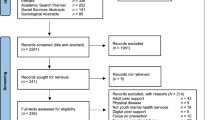Abstract
Introduction
Support group participation has various benefits for cancer survivors. This study explored the provision of support groups for cancer survivors in the United Kingdom (UK), and examined differences between professionally and peer-led groups.
Methods
Leaders of cancer support groups in the UK were invited to take part in a national postal survey. Questionnaires included sections for group structure information, and leader characteristics and training needs.
Results
Survey response was 59.6% with a total of 315 participants. Of these, 227 (72.1%) were peer-leaders, and 88 (27.9%) health-professional leaders. Peer-led groups were more likely to be run by a committee (66.1% vs 27.3%; χ 2 = 38.6; p < 0.001) and provide additional activities (e.g., home visits, telephone support, social events) than professionally-led groups. There were no differences between professional and peer leaders in the number of years of support group leadership experience, and previous support group training. However, more professional leaders perceived a need for training than peer leaders (67.0% vs 48.0%; χ 2 = 9.2; p = 0.002), although the types of training desired were not different.
Conclusions
Support group provision was widespread and varied in nature. Few differences were observed between peer and professional groups. More professional leaders identified training needs than peer leaders, although types of training desired were similar.
Implications for cancer survivors
A wide range of support groups are available for cancer survivors in the UK. Peer-led groups are more common, and they are more likely to offer services in addition to regular meetings than professionally-led groups.


Similar content being viewed by others
References
Zabalegui A, Sanchez S, Sanchez PD, Juando C. Nursing and cancer support groups. J Adv Nurs. 2005;51:369–81.
Gottlieb BH, Wachala ED. Cancer support groups: a critical review of empirical studies. Psychooncology. 2007;16:379–400.
Campbell HS, Phaneuf MR, Deane K. Cancer peer support programs-do they work? Patient Educ Couns. 2004;55:3–15.
Hoey L, Ieropoli SC, White VM, Jefford M. Systematic review of peer-support programs for people with cancer. Patient Educ Couns. 2008;70:315–37.
Slevin ML, Nichols SE, Downer SM, Wilson P, Lister TA, Arnott S, et al. Emotional support for cancer patients: what do patients really want? Br J Cancer. 1996;75:1275–9.
Butow PN, Kirsten LT, Ussher JM, Wain GV, Sandoval M, Hobbs KM, et al. What is the ideal support group? Views of Australian people with cancer and their carers. Psychooncology. 2007;16:1039–45.
Deans G, Bennett-Emslie GB, Weir J, Smith DC, Kaye SB. Cancer support groups—who joins and why? Br J Cancer. 1988;58:670–4.
Docherty A. Experience, functions and benefits of a cancer support group. Patient Educ Couns. 2004;55:87–93.
Grande G, Myers LB, Sutton SR. How do patients who participate in cancer support groups differ from those who do not? Psychooncology. 2006;15(4):321–34.
Montazeri A. A descriptive study of a cancer support group. Eur J Cancer Care. 1996;5(1):32–7.
Lydon A, Ryan-Woolley B, Amir Z. Function of cancer support groups: a telephone survey. Cancer Nurs Pract. 2009;8(8):12–9.
Macmillan Cancer Support. Directory of cancer self-help and support and user groups. London: Macmillan Cancer Support; 2007.
Dillman D. Mail and internet surveys: the Tailored Design Method. New York: John Wiley & Sons; 2000.
Edwards P, Roberts I, Clarke M, DiGuiseppi C, Pratap S, Wentz R, et al. Increasing response rates to postal questionnaires: systematic review. Br Med J. 2002;324:1183–92.
Gore-Felton C, Koopman C, Bridges E, Thoresen C, Spiegel D. An example of maximizing survey return rates: methodological issues for health professionals. Eval Health Prof. 2002;25:152–68.
Cancer Research UK. Cancer Stats 2008 (available from http://info.cancerresearchuk.org/cancerstats/incidence/prevalence accessed 16/09/2009).
Payne S, Smith P, Dean S. Identifying the concerns of informal carers in palliative care. Palliat Med. 1999;13:37–44.
Ussher J, Kirsten L, Butow P, Sandoval M. What do cancer support groups provide which other supportive relationships do not? The experience of peer support groups for people with cancer. Soc Sci Med. 2006;62(10):2565–76.
Steginga S, Pinnock C, Gardner M, Dunn J, Gardiner RA. Peer support groups for prostate cancer: a snapshot in 2002. Cancer Forum. 2002;26(3):169–72.
Price M, Butow P, Kirsten L. Support and training needs of cancer support group leaders: a review. Psychooncology 2006;15:651–663
Butow P, Ussher JM, Kirsten LT, Hobbs KM, Smith K, Wain GV, et al. Sustaining leaders of cancer support groups: the role, needs and difficulties of leaders. Soc Work Health Care. 2005;42(2):39–55.
Asch D, Jedrziewski MK, Christakis NA. Response rates to mail surveys published in medical journals. J Clin Epidemiol. 1997;50(10):1129–36.
Office for National Statistics. Census 2001: results and information (available from http://www.statistics.gov.uk/census2001/census2001.asp accessed 10/07/2009).
Acknowledgements
This study was funded by Macmillan Cancer Support. The North Manchester and Bury Myeloma Support Group assisted with questionnaire pre-testing.
Author information
Authors and Affiliations
Corresponding author
Rights and permissions
About this article
Cite this article
Stevinson, C., Lydon, A. & Amir, Z. Characteristics of professionally-led and peer-led cancer support groups in the United Kingdom. J Cancer Surviv 4, 331–338 (2010). https://doi.org/10.1007/s11764-010-0129-7
Received:
Accepted:
Published:
Issue Date:
DOI: https://doi.org/10.1007/s11764-010-0129-7




